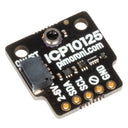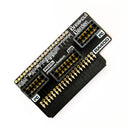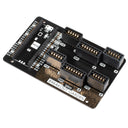ICP-10125: Ultra-precise Barometric Pressure and Temperature Sensor
by Pimoroni



An ultra precise barometric pressure and temperature sensor, mounted on a Breakout Garden/Qwiic/STEMMA QT compatible I2C breakout.
The ICP-10125 sensor uses MEMS capacitive technology - it's a flexible diaphragm over a chamber lined with conductive layers, that acts as a capacitor. This makes for a high precision, low power way of measuring changes in atmospheric pressure with an accuracy of ±1 Pa. You can use the pressure reading to calculate changes in altitude as small as 8.5 cm (that's the height of a medium-sized orange, the long side of a Pi 4 or 0.05 fathoms). It also measures temperature, with an accuracy of ±0.4 °C.
We could see this sensor coming in useful in all sorts of projects that involve measuring vertical movement accurately, like elevators, robot arms, drones, science kites and DIY test your strength machines.
This breakout is compatible with our fancy Breakout Garden system, where using breakouts is as easy just popping it into one of the slots and starting to grow your project, create, and code. It's also Qw/ST compatible so it can be plugged into a whole range of different microcontrollers and HATs with Qwiic or STEMMA QT connectors.
Features
- TDK InvenSense ICP-10125 Barometric Pressure and Temperature Sensor (datasheet)
- I2C interface, with address 0x63
- Qwiic/STEMMA QT connector
- 2-6V compatible
- Reverse polarity protection (on Breakout Garden connector)
- Raspberry Pi-compatible pinout (pins 1, 3, 5, 7, 9)
- Compatible with Raspberry Pi (Python library).
- Compatible with Raspberry Pi Pico (C++/MicroPython libraries).
- Schematic
Kit includes
- ICP-10125 breakout
- 1x5 male header
- 1x5 female right angle header
We've designed this breakout board so that you can solder on the piece of right angle female header and pop it straight onto the bottom left 5 pins on your Raspberry Pi's GPIO header (pins 1, 3, 5, 7, 9). The right angle header also has the advantage of positioning the breakout away from the Pi's CPU so as to minimise radiated heat.
Software
We've put together a handy Python library for this sensor, with examples showing how to read the sensor and how to use the pressure reading to calculate altitude.
You can also use this breakout with Raspberry Pi Pico and other RP2040 boards, using C++ or Pirate brand MicroPython.
Notes
- Dimensions: approx 19mm x 19mm x 5mm (L x W x H, including connector)
-
ICP-10125: Ultra-precise Barometric Pressure and Temperature Sensor
PIM586£11.75
Essentials
Other things that could come in handy!
-
Breakout Garden Mini (I2C)+ £9.00
-
 Breakout Garden for Raspberry Pi 400 & 500+ £9.00
Breakout Garden for Raspberry Pi 400 & 500+ £9.00 -
 Pico Breakout Garden Base+ £11.00
Pico Breakout Garden Base+ £11.00 -
 Pico Breakout Garden Pack+ £6.25
Pico Breakout Garden Pack+ £6.25 -
 4 Pin JST-SH Cable (Qwiic, STEMMA QT, Qw/ST) – JST-SH to JST-SH (200mm)+ £1.25
4 Pin JST-SH Cable (Qwiic, STEMMA QT, Qw/ST) – JST-SH to JST-SH (200mm)+ £1.25
Shop with confidence – we've been serving the hobbyist electronics, Maker, and retro gaming communities since 2012.
- Satisfaction or refund guarantee
- Worldwide shipping via mail or courier
- 57,000+ customer reviews
- Secure website and payments




